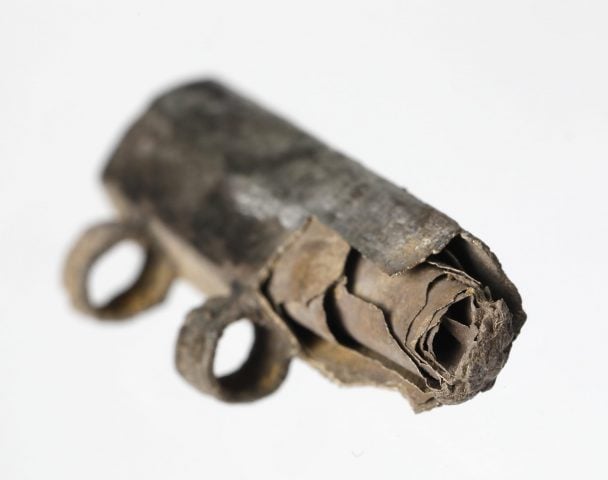Art Collectors
Mumbai Collector Sangita Jindal on Her Sprawling New Contemporary Art Center in Ancient Hampi
Bridging the traditional and modern, Hampi Art Labs is the latest venture from the prominent patron and philanthropist.
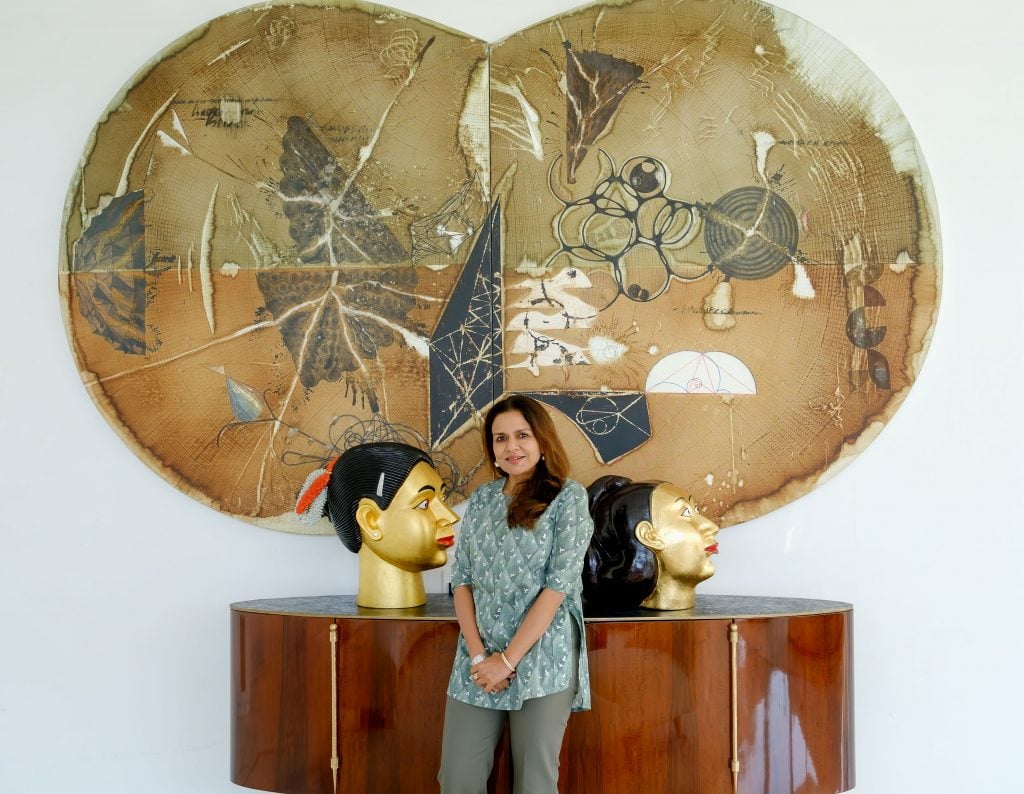
Sangita Jindal has been captivated by the ancient city of Hampi in South India since she first laid eyes upon the UNESCO World Heritage Site in the early 1980s. Hampi, explained the prominent art collector and philanthropist, was a “dynamic hub where art, architecture, and literature flourished from the 14th to 16th centuries.”
As many as 1,000 temples, shrines, and other monuments were intricately carved out of local granite during Hampi’s heyday. Many of them still stand, making the site a major tourist destination and an auspicious location for Jindal’s long-planned, newly opened art center.
Hampi Art Labs—with its organic, stone-like forms designed by architect Sameep Padora—promotes the creation of contemporary art through residencies and workshops that bridge past and present disciplines. It’s the latest initiative from JSW Foundation (which Jindal chairs), the philanthropic wing of the Mumbai-based conglomerate JSW Group (which her husband leads). Together, the couple is well-known for supporting arts and heritage projects in India.
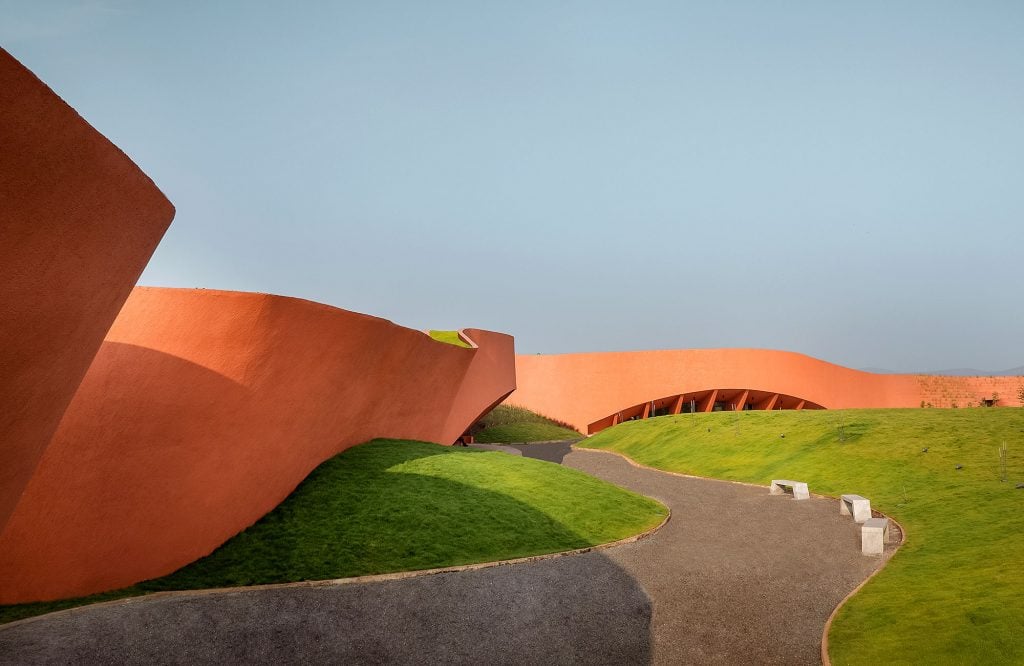
Hampi Art Labs, 2024. Courtesy of Hampi Art Labs.
The center’s debut exhibition, “Right Foot First,” was named, said Jindal, after the Hindu custom of entering a space with the right foot to bring good fortune. The show, which runs through May 31, features a mix of established names and rising stars from the Sangita Jindal Collection, including Zarina Hashmi, Atul Dodiya, Shilpa Gupta, Dayanita Singh, Reena Saini Kallat, and Bharti Ker. The aim is to highlight key moments in Indian art from the last 25 years.
Jindal has been collecting Modern and contemporary South Asian art since she was a teenager. Today, she said, her collection holds around 1,000 works by both Indian and global artists. Her art patronage and philanthropic pursuits have been recognized the world over. She’s a trustee of the World Monuments Fund (India chapter), a global trustee of the Asia Society, and a member of the Tate International Council.
Here, she offers a glimpse into her collecting expertise, her protection of heritage sites, her vision for Hampi Art Labs, and how she brings it all together.
You have been collecting South Asian art for some time. What was your first purchase?
Inheriting my passion for the arts from my mother Urmila Kanoria when growing up in Kolkata, I bought my first artwork when I was 19. It was a small painting from Anjolie Ela Menon, a figurative painter and one of India’s leading contemporary artists. Having developed a distinct artistic language influenced by Byzantine iconography and European Renaissance art, Menon plays an important role in the canon of art history in India. Menon was also acquainted with my mother and visited her artist residency program at Kanoria Centre for Arts, which my mother founded in the 1980s in Ahmedabad.
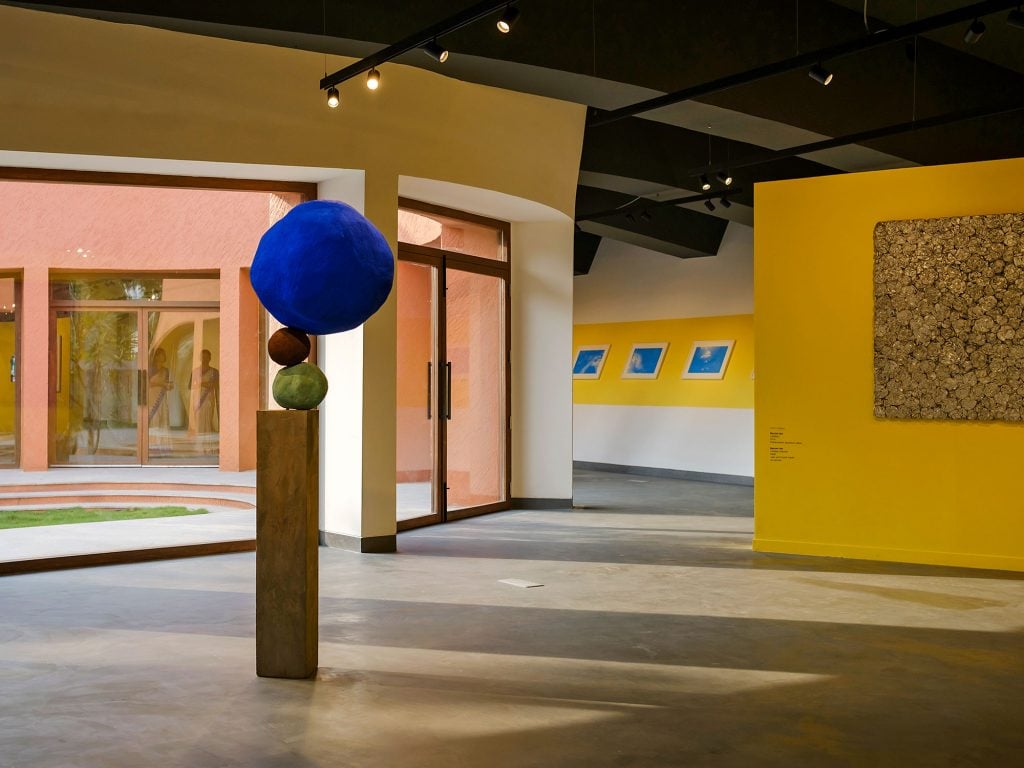
Installation view of “Right Foot First” with works by Annie Morris (left), Rohini Devasher (center) and Manish Nai (right). Courtesy of Hampi Art Labs.
What is your vision for Hampi Art Labs and how does the Jindal Collection factor into it?
As a chairperson of JSW Foundation, the social development arm of the JSW Group, I have overseen over 25 years of support for art and heritage in India. This includes initiatives such as publishing Art India magazine, setting up the Jindal Arts Creative Interaction Centre at the National Centre for the Performance Arts, and supporting important art fairs like India Art Fair, where this year we commissioned a special installation by Jitish Kallat.
Hampi Art Labs marks the next chapter in JSW Foundation’s legacy. Together with my daughter Tarini, who brings her own expertise in design, craftsmanship, and sustainability, I founded the center to bring together artworks, artists, loans, site-specific installations, and commissions across materials and methodologies with the aim to forge cultural links across South Asia and beyond. There are few spaces in India like Hampi Art Labs, and the center responds to the need for a place of art production and experimentation instead of display within India’s art ecosystem. Hampi Art Labs will also host traveling exhibitions with like-minded institutions and organizations.
Hampi Art Labs’ residency program invites artists from across practices for three-month-long residency cycles. Production facilities will include workshops for printmaking, stone and metal sculpture, ceramics, and new media. The proximity of JSW’s steel plant gives them the opportunity to work on a very large scale with specialized equipment. Here, artists can learn from the region’s richly replete craft culture and distinctive traditions and techniques.
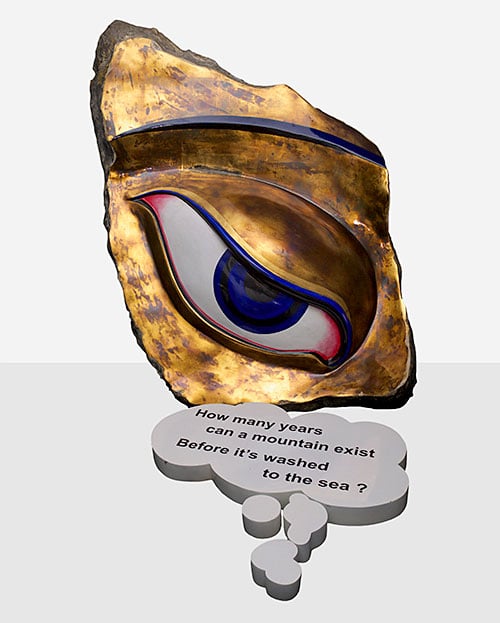
Tushar Joag, Eye (2007). Courtesy of Sangita Jindal Collection.
Please tell us about the debut exhibition “Right Foot First.”
From 1994, I started acquiring art with a view to build the Sangita Jindal Collection that we see today, consisting of approximately 1,000 works by leading Indian and global artists. Many of these works are on view at the JSW Group Headquarters in Mumbai. The first public exhibition at Hampi Art Labs, “Right Foot First,” draws from this collection and will include works from Zarina Hashmi, Shilpa Gupta, Bharti Kher, Annie Morris, Andy Warhol, and Ai Weiwei, among others.
Taking its title from the auspicious Hindu belief to always enter a new space with the right foot for good fortune, the exhibition invites audiences to observe intergenerational dialogues between works of multiple artistic disciplines, highlighting pivotal moments within Indian contemporary art over the past 25 years. The exhibition design reflects the flow of the river systems that surrounded the ancient city of Hampi and reminds us that time, history, and creative process are not linear. The site is known for its spiritual energy, striking temples, and exceptional natural beauty dominated by the river Tungabhagra, craggy hill ranges, and open plains.
What is your philosophy when it comes to collecting?
To me, collecting is a matter of personal choice and instinct. A work of art needs to speak to me; it needs to touch something inside me and give a sense of deeper meaning. It does not matter whether the artist is well-known. My mother introduced me to artists, designers, and architects from an early age, which is how I started to develop my taste. As a result, I befriended many artists, which has become an integral part of my collection process. I realized that art can offer a different perspective on life. Like my mother who passed down her love for art to me, I share my love for art with my daughter Tarini.
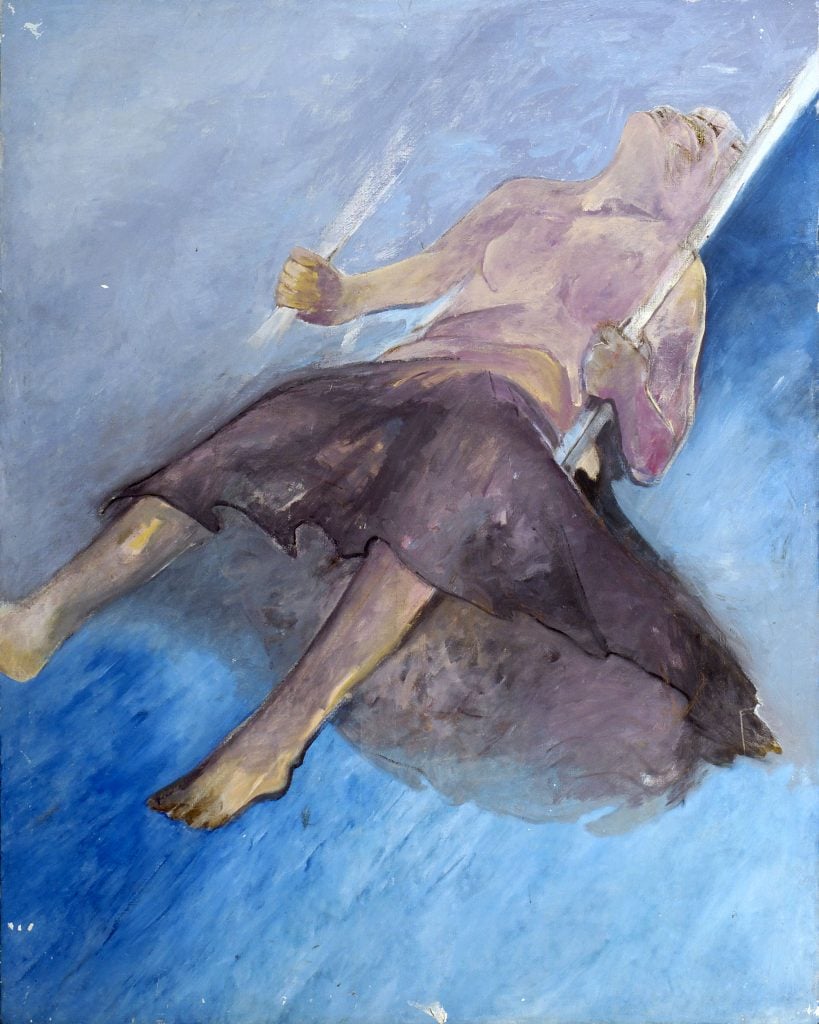
Krishen Khanna, Girl on a Swing (ca. 1990s). Courtesy of Sangita Jindal Collection.
What is a favorite work in your collection?
My favorite work is Krishen Khanna, Girl on a Swing (ca. 1990s). It denotes freedom for me in a society where you are expected to follow norms. This swing represents the ability to dream and bring fantasy into your life. To me, Krishen Khanna’s work symbolizes the purpose of existence.
Which works or artists are you hoping to add to your collection this year?
I’ve just bought three works from Sohrab Hura, in whom I see huge potential. His works trigger certain emotional responses when I look at them. The compositions of his works are simple, and they have beautiful watercolor hues. As if I can feel that material. I look forward to hanging his works in my home.
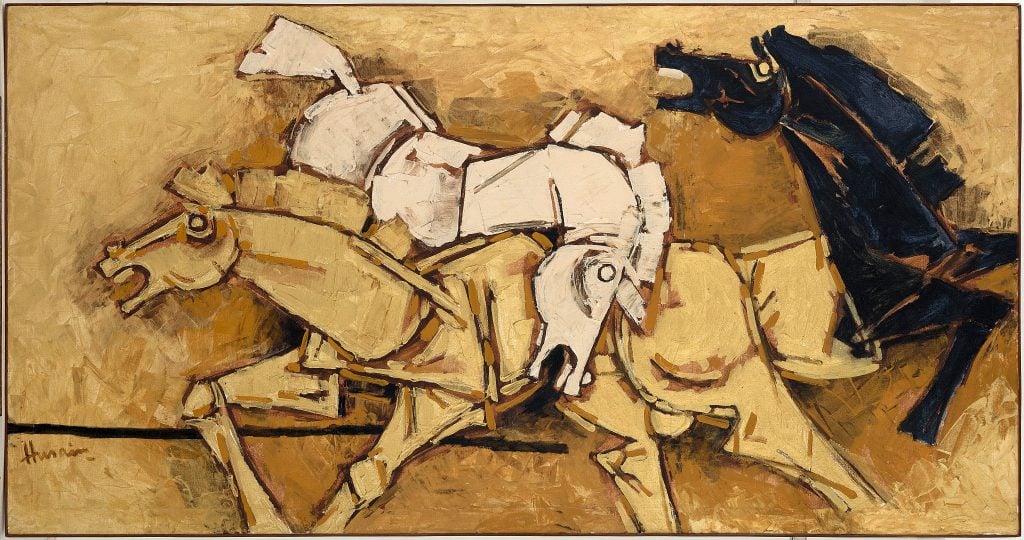
M.F. Husain, Untitled (ca. 1980s). Courtesy of Sangita Jindal Collection.
What is the most valuable work of art that you own?
The painting I value the most is M. F. Husain’s Horses (ca. 1980s). At the time that I wanted to buy the painting, it was very expensive, and I had to save up a lot of money to acquire it. I eventually bought it from Rajni Patel in Mumbai in 1983. For me, it is a very lucky painting because my life grew from the moment I bought it. The horses in that painting galloped into my life, and the work has provided inspiration to strive for what I have achieved.
Where do you buy art most frequently?
I tend not to buy artworks at auction but instead prefer to buy them from artists directly via the galleries that represent them. Having direct contact with the artist is very important to me. I feel like if I know the artist, I value the artwork more. I don’t have a curator or an expert who advises me about what to buy. I buy works based on my own intuition. I visit many galleries, speak to artists, and read a lot of different publications. One of them is of course Art India, the magazine that I founded in 1996. It has won several national awards for printing and content and is recognized internationally as the most important independent voice on contemporary art from India. The publication has been responsible for the promotion of a critical discourse around diverse art forms and disciplines. Coinciding with the opening of Hampi Art Labs, Art India will relaunch with a new format in February, including more guest editors in its editions. February will also see the publication of the Art India Book of Interviews and the Art India Book of Essays.

Alwar Balasubramaniam, Untitled (2020). Courtesy of Sangita Jindal Collection.
What work do you have hanging above your sofa?
I have a work by Alwar Balasubramaniam from Talwar Gallery in New York above my sofa. It is the most beautiful work that I have.
What is the most impractical work of art you own?
Ai Weiwei’s Porcelain Vases with Bamboo Poles (2008) is the most impractical work (which is part of Hampi Art Lab’s first public exhibition “Right Foot First”). It is impractical to install, as it is very tall, and it needs to be placed within the right context as it has political connotations. In “Right Foot First,” the work is placed in dialogue with Atul Dodiya’s Arati (2003), with which it shares the language of art and politics.
What work do you wish you had bought when you had the chance?
I was offered Antony Gormley’s Iron Baby (1999) but I dilly-dallied for too long. By the time I decided to buy it, it was sold.




